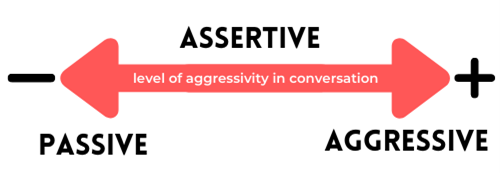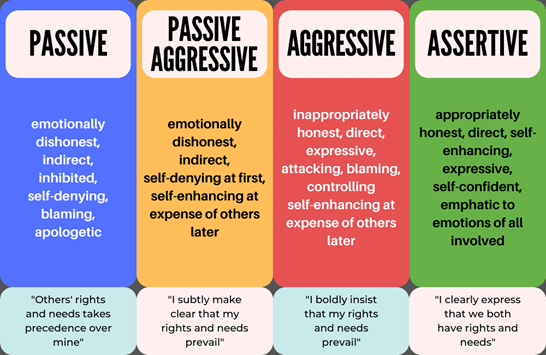Content begins here
Contenido de la página principal
Pulsa para colapsar
Assertiveness
Introduction
Have you ever been in a situation like this?
- You're queuing to pay at the supermarket, and someone sneaks up on you. You get angry but you don't dare to say anything to him.
- A friend asks if you can explain tomorrow's test to him. You are overwhelmed, you have to study other things, despite that you say yes because you don't want him to get angry with you.
- You have been thinking for a long time that you should talk to your parents, you think that they don’t recognize the help you are giving in your family, but you don’t do it because it seems to you that it’s never a good time to face it.
In any of these cases, you should have said what you thought but you didn't.
By not expressing your feelings, you are left with a feeling of frustration and you feel that you are losing respect for yourself. Passively accepting these types of situations can push you to the limit and cause you to finally erupt with anger, and become angry, which is much worse than having expressed what you thought at the time by controlling your message so that it was not too aggressive or so weak that you will not clearly state what you were trying to say.
Thus, assertiveness is often defined as the ability to express opinions, feelings, attitudes and desires, and claim one's rights, at the right time, without undue anxiety, and in a way that does not affect the rights of individuals.
Learning to communicate assertively will be useful for you to give your opinion, reject requests without making others feel hurt with you, express your negative emotions, share your feelings and encourage others to share their experiences with you, solve problems before your situation gets emotional, out of control, etc.
Once this lesson is completed and approved, learners will be able to:
- Know the different styles of communication.
- Understand the difficulties of being assertive.
In this lesson, we will learn how to become more assertive.
Different styles of communication
The most widespread model to identify and classify these styles is through a continuous axis of aggressiveness in said interaction: Passive, the least aggressive, Assertive, the one with a balanced tone in terms of aggressiveness towards the interlocutor and, finally, in the most aggressive extreme, the Aggressive.

In addition to these three styles, a fourth style called Passive-Aggressive is identified. The person who uses this style of communication, depending on the moment in which he is, will feel the emotions of the passive or the aggressive.
1. Aggressive style:
WHAT IT IS: This style of communication is characterized by expressing ideas, feelings, needs, opinions, in an inappropriate way and without respecting the rights of others.
WHAT IS INTENDED: achieve what you want, but hurting other people (with words, gestures, looks ...) or forcing them to do things they do not want to do. The goal of this way of communicating is to dominate the other person.
IN WHAT KIND OF PEOPLE IS IT MOST FREQUENT: it is a communication style typical of those who have frequent interpersonal conflicts, often feel guilt and frustration, in addition to having a bad image of themselves even though they appear otherwise.
SOME EXTERNAL CHARACTERISTICS: gaze; high voice volume; they speak fluently and quickly, sometimes hastily; threatening gestures; intimidating posture; clenched, tight fists.
2. Passive style:
WHAT IT IS: This style of communication is based on not expressing thoughts and feelings that in normal situations should be expressed.
WHAT IS INTENDED: avoid communication because you fear the possibility of not pleasing others, or because there is something you want to hide. In short, with this style of communication, “you don't take risks”.
IN WHAT KIND OF PEOPLE IS IT MOST FREQUENT: It is a communication style typical of shy, insecure, or introverted people.
SOME EXTERNAL CHARACTERISTICS: relatively poor eye contact, low tone of voice, short responses, and non-verbal language that expresses an insecure attitude.
3. Assertive style:
WHAT IS IT: Through this style of communication, what you think, and feel is expressed directly; communicates honestly and transparently, but without trying to dominate the other person.
WHAT IS INTENDED: establish a balance in which both your interests and those of the other person are considered.
IN WHAT KIND OF PEOPLE IS IT MOST FREQUENT: in those people who feel good about themselves and with others, with high emotional intelligence, which leads them to be aware of their feelings, those of their interlocutor, and to act accepting both some like others.
SOME EXTERNAL CHARACTERISTICS: They maintain direct eye contact, have a fluent manner of speaking and a normal tone of voice.

Source: https://liveboldandbloom.com/07/self-improvement/assertiveness-exercises
Understand the difficulties of being assertive:
It is difficult for all of us to be assertive because we tend to always try to please others, and thus avoid conflicts. The education we have received, aimed at satisfying others and putting them ahead of our interests, can be a “double-edged sword” since something good (thinking about others) can lead us to shut up when we should express our opinion or feelings.
The origin of the difficulties when it comes to being assertive can be found in:
- The lack of self-esteem and confidence, which will lead you to allow your rights to be violated and not to defend your interests. By behaving like this, you can cause the people around you to get used to not taking you into account.
- Stress or nerve, which can lead you to express your emotions in an extremely aggressive or passive way. This behaviour will increase the feeling of anxiety and will cause the rejection of the people who listen to you.
- Because of your personality type, don't be surprised if you find that by nature you tend to be more passive or more aggressive; It is good that you know yourself to know what you have to work to achieve to be more assertive.
- For your previous experiences, We are all affected by the type of education we have received, and our character development is influenced by the type of people with whom we have lived: helpful and cordial or perhaps more aggressive and hostile. This causes your natural way of reacting to tend towards passivity or aggressiveness.
How to achieve a higher level of assertiveness.
Once you have identified what communication style you tend to and what may be affecting your lack of assertiveness, we present some tools to achieve a higher level of it:
Think positive:
You cannot avoid the negative feeling that denying a person a favour can cause you, but you can counteract that negative feeling with a positive thought that reaffirms that you deserve respect and that your rights are valued.
Only you can express what you carry inside:
The people around you cannot know what happens to you if you don't tell them. Sometimes we pretend that everyone knows what we feel, what bothers us and what we are thinking without us saying it, and that is an excuse not to step up and say it for ourselves.
Have an action plan:
Assertiveness is not just about expressing what you are thinking; If what you want is to achieve a goal, you must be clear about the actions you are going to propose so that what you want is achieved.
Base yourself on concrete facts:
When you have a conversation about something that has happened and that has generated a negative feeling, it is important to explain yourself on the objective events that have occurred and not so much on your judgment about those events.
Convey your emotions:
In the previous lesson, we discussed empathy. This ability also plays an important role in the way you express yourself assertively.
When you describe how you feel, you will be able to make the other person empathize with your feelings and therefore, you will make them understand you better and take what you are expressing well.
Conclusion:
To the extent that we learn to communicate more assertively, we will be able to strengthen our self-esteem, achieve our goals through open and understanding dialogue, while generating healthy bonds with the people around us.
Like all skills, you can always improve and grow in them. Don’t worry if sometimes you don’t express yourself assertively, you are always in time to rectify and ask for forgiveness if you have hurt someone or you have not been able to express in time the feelings that a complicated situation was generating.
Bibliography:
Video and PDF presentationPulsa para colapsar
The following video explains the content of this lesson and shows some examples:
Video T3L2. Assertiveness
Here you have the content of the video in pdf in case you need to use it in your classroom:
Lesson contents in PDFPulsa para colapsar
Here you have the contents of the lesson in PDF:

